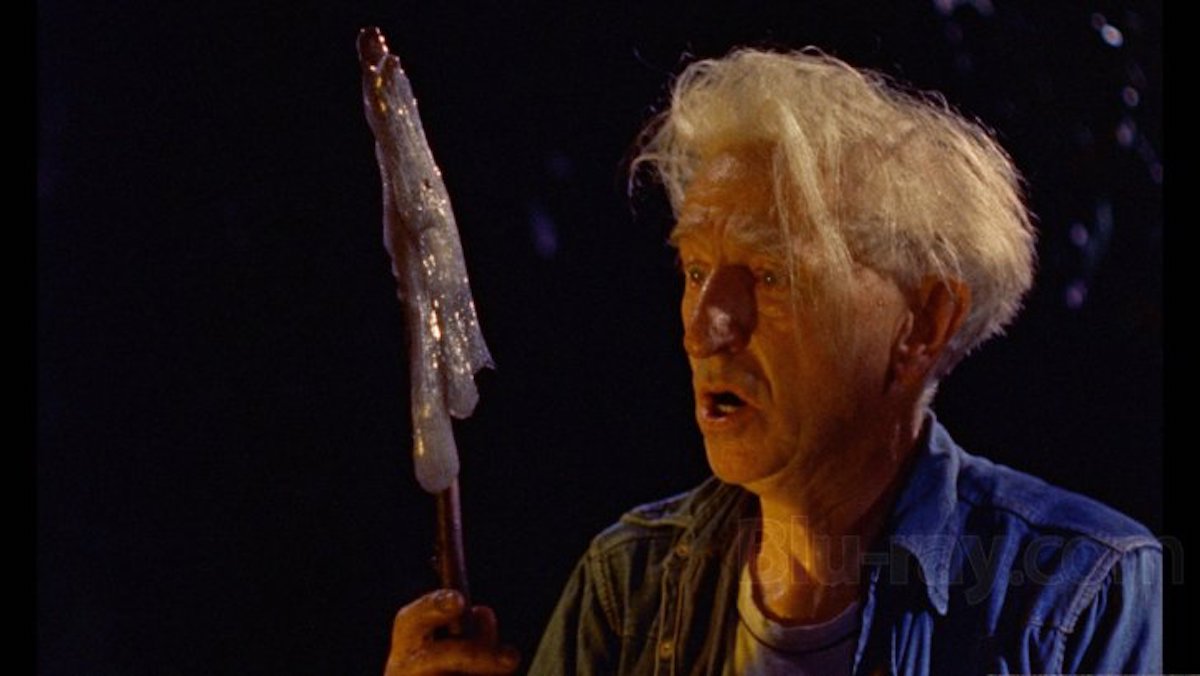Philadelphia, 1950. Two patrolling police officers witness an object falling from the sky, then discover a mysterious, glowing ooze hanging off a corner telephone pole. As they go in for a closer look, the blob begins not just to move, but to crawl. The cops call for back-up and give chase, following the “thing” into a field. Compelled by curiosity, one of the officers reaches out and puts his hand into the purple goo; the substance falls apart immediately, leaving no trace of its existence. Outside of some very confused cops, anyway.
If the above sounds like the beginning of a horror movie to you, well, you’re not alone. Eight years after Philly’s curious incident of the glob in the nighttime, a pair of Pennsylvania filmmakers spun hazy memories of the event into drive-in staple The Blob. The Steve McQueen-led film became a monster-movie classic about a man-eating jelly that falls from space and terrorizes a Philadelphia suburb.
Released in the fall of 1958, The Blob was an unlikely hit, spawning numerous rereleases, a sequel, and a gorier remake in 1988. The Blob‘s influence can even be seen in everything from Ghostbusters II to James Gunn’s Slither to the Mind Flayer in Stranger Things. A large part of that lasting legacy can be tied to the uniqueness of the movie’s unstoppable, undulating monster. Ironic, really, given that the idea was most likely cribbed from a half-remembered headline.
The mid-1950s found former Vaudevillian and film distributor Jack Harris eager to break into producing. He wanted to make a monster movie, and a good one, but he was having a hard time coming up with a hook. So he asked his friend (and fellow Pennsylvanian) Irvine H. Millgate for help. Over a middle-of-the-night phone call, the latter pitched him the bare-bones story of a meteorite and a mysterious space jelly that crashes down right outside of Philadelphia.
Though neither Harris nor Millgate—nor screenwriters Kay Linaker and Theodore Simonson, for that matter—ever officially confirmed the connection, they never denied it either. After all, it’s hard to believe that the film didn’t draw inspiration from the 1950 incident. Much of the fictional blob’s discovery and description matches up with the real-life one, right down to the purplish hue. Never mind that The Blob was filmed on a soundstage in Valley Forge, written by and starring mostly Pennsylvania locals who would have remembered the media circus of a few years prior.

Sony Pictures Television
Following its discovery by Philadelphia police, both the FBI and U.S. Air Force were called in to investigate the “flying saucer” that had crashed and dissolved without a trace. The incident made a number of headlines at the time, too; the story was distributed nationally by the Associated Press. But no one was ever quite able to explain what that glowing ooze really was. Not that scientists (and conspiracy theorists, and Enlightenment poets) haven’t tried.
Here’s where things get even crazier: what happened in Philadelphia 70 years ago wasn’t an isolated event. As unbelievable as it already is that The Blob was based on anything from real life, it turns out that mysterious, disappearing space goo has been falling across the globe for centuries. The phenomenon is known as pwdre ser (pronounced “poodra sair”)—Welsh for “the rot of the stars.” It was given its name all the way back in the 1600s and has reoccurred sporadically throughout history. Notable incidents hit Tasmania in 1996 and Scotland in 2009. From the earliest sightings in the 1400s, the blobs—also known as “star jelly,” “earth-stars,” and “star-slime”—have long been associated with meteorite showers. They were originally alleged to be, essentially, melted space rocks.

Sony Pictures Television
Most modern scientists have been quick to poo-poo that theory. Meteorites don’t melt, and gelatinous substances would never survive a plummet through Earth’s atmosphere. Other discredited hypotheses suggested that the blobs were slime molds, fungi, bacterial algae byproducts, or even caustic soda from battery reprocessing plants.
So, what is the star-rot then? Well, we don’t know. The most widely accepted theory is that the star jelly is some kind of animal regurgitation. Popular contenders include frog spawn or partially-digested poisonous toads being barfed back up by birds. A few scientists have more specifically posited that the mysterious ooze is the result of pre-ovulation frog oviducts being swallowed and regurgitated, and then swelling dramatically with moisture from avian digestive tracts.
Confounding matters, though, is the fact that no frogs’ eggs have ever been found within any sample of pwdre ser. Also missing: DNA. Literally any kind. Following all those reports of earth-stars landing in Scotland in 2009, scientists at Edinburgh’s Royal Botanic Gardens decided that enough was enough. They examined several samples. While they fell short of shouting “Aliens!” at the tops of their lungs, they were forced to conclude that the star-rot was neither plant nor animal

Sony Pictures Television
Add to the above the fact that even the most swollen of regurgitated frog parts doesn’t reach six-feet across (the reported length of many pwdre ser puddles). Plus, there’s the constant coinciding with meteor showers across half of human history. Thus, the blobs’ origins remain purely and steadfastly theoretical.
In the end, 1958’s The Blob, whether intentionally or otherwise, got a lot more right about the phenomenon of pwdre ser than most would probably give the cheesy B-movie credit for. Does that mean that interstellar space goo is going to destroy the human race? No, of course not, and saying that would be ridiculous and irresponsible. But much like The Blob’s creators and a certain real-life event that inspired everything, we’re not not saying that, either.
Featured Image: Sony Pictures Television

